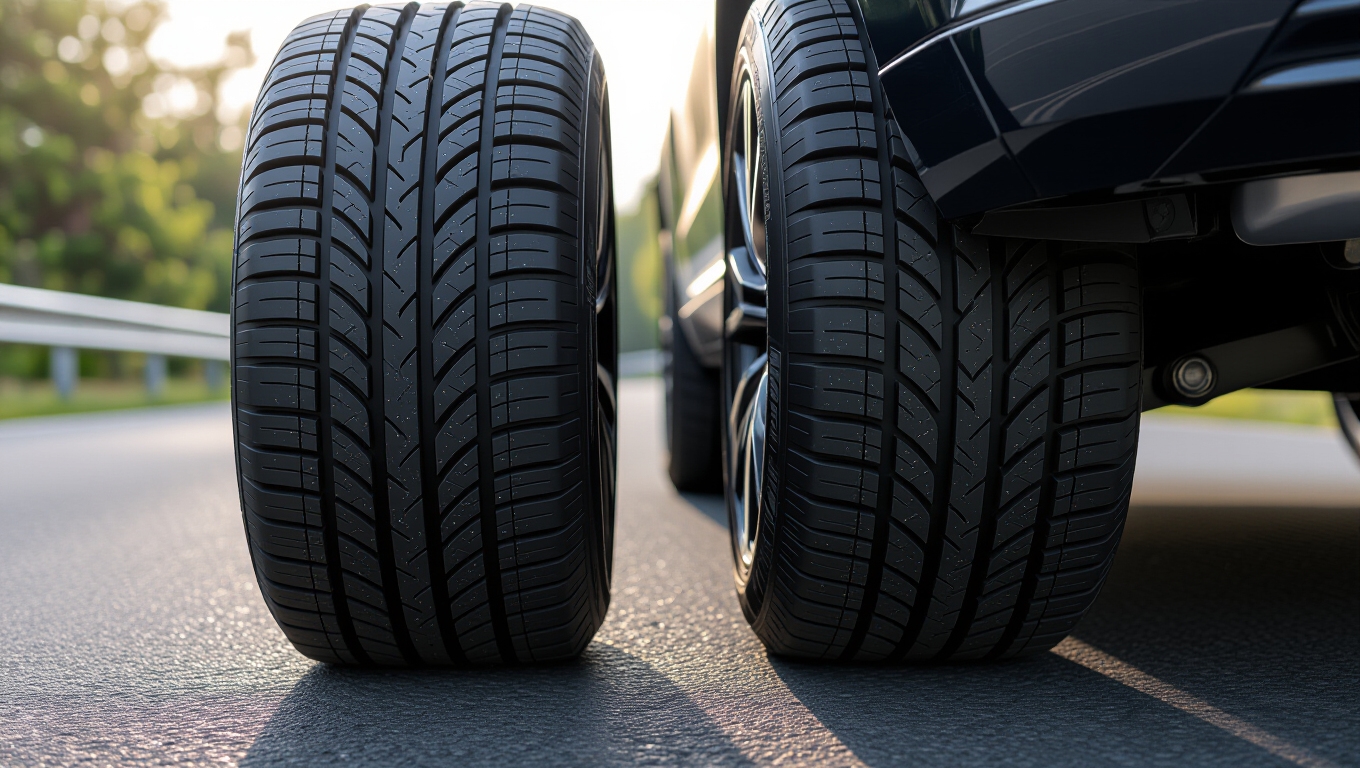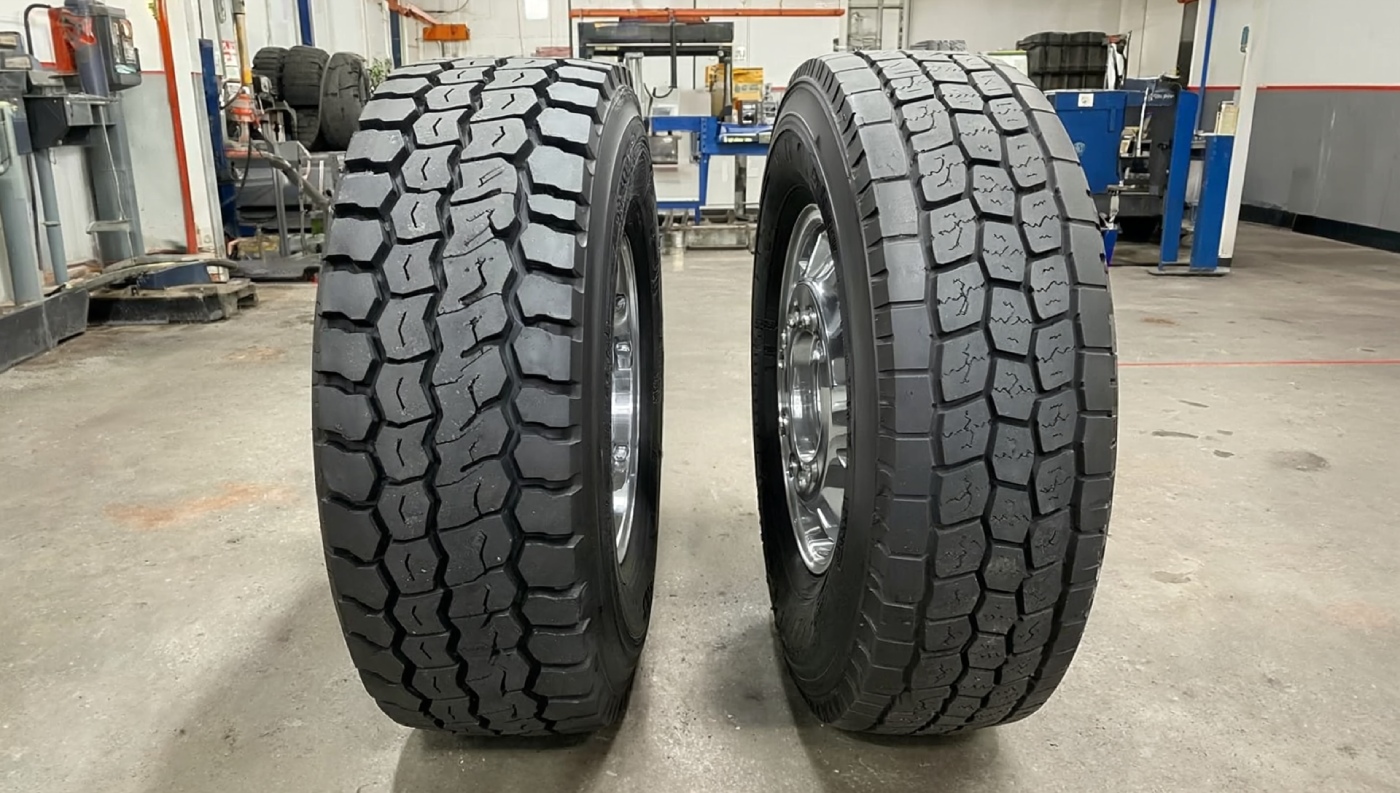If you’re choosing between closed and open shoulder tires, know that closed shoulders have continuous ribs providing better highway stability, lower noise, and improved fuel efficiency due to reduced rolling resistance. Open shoulders, with wider gaps and aggressive blocks, excel in off-road traction and self-cleaning on mud or snow but wear faster and generate more noise. Your selection depends on whether you prioritize on-road comfort and durability or off-road grip and rugged performance. Explore the specifics to match your exact driving needs.
Key Takeaways
- Open shoulder tires have aggressive, widely spaced blocks ideal for off-road traction and self-cleaning in mud, snow, and rocky terrain.
- Closed shoulder tires feature continuous ribs that enhance highway stability, precise handling, and reduced rolling resistance for better fuel efficiency.
- Open shoulder designs generate higher road noise and vibrations, reducing ride comfort on paved surfaces compared to quieter closed shoulder tires.
- Closed shoulders promote even tread wear, longer tire life, and reduced heat buildup, while open shoulders wear faster and are prone to chipping.
- Closed shoulder tires are best for urban and highway use, whereas open shoulder tires excel in rugged off-road and construction environments.
Design and Structural Differences Between Closed and Open Shoulder Tires
When comparing closed and open shoulder tires, you’ll notice that their fundamental design differences markedly affect performance and application.
Open shoulder tires feature large gaps between tread blocks, creating aggressive, widely spaced shoulder blocks that extend outward, enhancing debris clearance and heat dissipation. These designs are especially beneficial for vehicles operating in environments requiring frequent maintenance inspections due to harsh conditions.
Open shoulder tires have wide gaps and aggressive blocks that improve debris clearance and heat dissipation.
Conversely, closed shoulder tires employ a continuous solid rib or tightly angled shoulder blocks, forming a compact, smooth edge optimized for stability on paved roads.
Structurally, open shoulders use more aggressive rubber compounds and flexible blocks for rugged terrains, while closed shoulders prioritize reinforced ribs and compounds aimed at reducing rolling resistance and promoting uniform wear. The shoulder area influences handling as well as traction, noise levels, and tire lifespan.
These design distinctions influence heat management, tread longevity, and load distribution, with closed shoulders favoring high-speed durability and open shoulders offering adaptability in demanding off-road conditions.
Traction Performance on Various Terrains
When you tackle off-road conditions, open shoulder tires provide superior traction through widely spaced blocks that dig into loose terrain and self-clean efficiently. Their open shoulder design allows mud, snow, and debris to eject easily, maintaining optimal grip. These tires are often preferred for variable terrain where consistent grip and debris clearance are essential.
On highways, closed shoulder tires offer enhanced grip and stability with their continuous contact patch, improving handling at high speeds. Understanding these distinctions helps you choose the right tire for your driving environment.
Off-Road Traction Capabilities
Although both closed and open shoulder tires have distinct designs, their off-road traction capabilities vary markedly across different terrains. You’ll find open shoulder tires excel in muddy, loose, snowy, and rocky conditions due to large voids and aggressive tread blocks that enhance bite, self-cleaning, and debris evacuation.
This design allows superior grip on uneven surfaces by channeling mud and water away, improving control and reducing hydroplaning risk. Additionally, open shoulder tires offer better heat dissipation, reducing the risk of overheating during intense off-road use. Their design parallels how miter gears excel in low-speed, low-load applications by optimizing performance with simpler structures.
In contrast, closed shoulder tires, with continuous ribs and tighter tread spacing, provide limited traction off-road, often sliding on soft or irregular terrain. Their smooth shoulders reduce mechanical grip and adaptability on rocks and wet surfaces. When you need reliable off-road traction, especially in demanding environments, open shoulder tires clearly outperform closed shoulder designs.
Highway Grip and Stability
Off-road performance highlights the strengths of open shoulder tires in challenging terrain, but their design affects highway behavior differently. When you drive on paved roads, closed shoulder tires excel by offering a continuous rib that maximizes contact with the surface.
This design stabilizes tread blocks, providing you superior lateral grip and precise steering, especially at high speeds. Closed shoulder tires are preferred for highway transportation, reducing tire wear and enhancing fuel economy through their compact tread pattern. Their design also helps minimize tread distortion, contributing to longer tire life and consistent performance.
In contrast, open shoulder tires’ segmented shoulders reduce surface contact, causing instability and increased tread squirm.
- Enjoy enhanced directional control with closed shoulders
- Experience less driver fatigue thanks to reduced tread distortion
- Benefit from quieter rides due to continuous tread patterns
- Maintain confident handling during sharp turns and lane changes
- Avoid hydroplaning risks with stable highway traction
Choosing closed shoulder tires ensures reliable grip and stability on highways.
Impact of Shoulder Design on Tire Longevity

Because shoulder design considerably influences tread wear and durability, understanding its impact on tire longevity is essential for selecting the right tire for your application. Closed shoulder tires feature a continuous solid rib along the shoulder, promoting even tread wear and enhancing structural integrity by distributing load more uniformly.
This design, combined with firmer rubber compounds, reduces tread wear and resists sidewall damage, resulting in longer tire life and better durability under heavy loads.
Conversely, open shoulder tires have widely spaced, flexible tread blocks that induce uneven wear and are prone to chipping and accelerated shoulder damage, especially on paved roads.
Additionally, closed shoulder tires generate less heat due to reduced tread block movement, slowing rubber degradation and extending service intervals—making them ideal for consistent highway use where longevity is critical. Proper heat management, similar to the principles behind heat reduction technologies in car window tints, can significantly enhance tire durability.
Fuel Efficiency and Rolling Resistance Comparison
You’ll notice that closed shoulder tires exhibit lower rolling resistance due to their continuous rib design, which directly enhances fuel economy. This design also allows for stiffer lug elements, which further reduces rolling resistance without sacrificing traction. In contrast, open shoulder tires incur higher energy loss from their aggressive tread voids, reducing efficiency on paved roads.
Understanding these design differences is critical when optimizing tire selection for fuel savings and operational cost reduction. Choosing components with higher performance efficiency can significantly impact overall vehicle operating costs.
Rolling Resistance Differences
While open shoulder tires offer enhanced traction through their widely spaced lugs and increased tread voids, they also generate higher rolling resistance compared to closed shoulder tires. The open design increases tread voids and sipes, which reduce rubber contact and elevate energy loss during rotation.
In contrast, closed shoulder tires feature continuous, interlocked ribs that minimize deformation and hysteresis, lowering rolling resistance. This difference affects tire efficiency and operational costs indirectly.
- Feel the difference as closed shoulders reduce energy loss for smoother rides
- Experience less tire deformation, extending tread life and consistency
- Avoid the frustration of uneven wear increasing rolling resistance over time
- Benefit from stiffer lugs that maintain stability and reduce heat buildup
- Trust closed shoulders to optimize performance on paved roads without sacrificing durability
- Similar to how clean filters improve vehicle efficiency by reducing resistance, maintaining optimal tire design reduces energy loss and operational costs.
Impact on Fuel Economy
Understanding how rolling resistance affects tire performance naturally leads to examining its direct influence on fuel economy. Closed shoulder tires, with their continuous rib design and tighter block spacing, minimize rolling resistance, directly enhancing fuel efficiency. This design reduces energy loss during rotation, especially at steady highway speeds, making them ideal for long-haul driving.
Their uniform wear pattern sustains fuel savings over the tire’s lifespan. Additionally, selecting tires that balance fuel efficiency with durability can significantly reduce overall operational costs for fleets. Similar to selecting the right motor oil, choosing components that optimize efficiency can lead to long-term savings, much like how synthetic oil performance impacts engine operation.
Conversely, open shoulder tires feature larger tread gaps and aggressive patterns that increase rolling resistance, causing higher fuel consumption on paved roads. While they improve traction off-road, their elevated energy demands and faster tread wear degrade fuel economy more rapidly. This is comparable to how some oils with lower viscosity retention may require more frequent changes, affecting maintenance costs and efficiency.
Hence, if fuel efficiency and long-term operational costs are priorities, closed shoulder tires offer measurable advantages in reducing fuel consumption under consistent driving conditions.
Tire Design and Efficiency
Because tire tread design directly influences rolling resistance, it plays a vital role in determining fuel efficiency. Closed shoulder tires feature continuous ribs that minimize tread deformation, reducing rolling resistance and enhancing fuel economy, especially on highways.
Conversely, open shoulder tires have large voids that increase friction and rolling resistance, leading to higher fuel consumption. When you choose tires, understanding this trade-off between traction and efficiency is essential for your driving needs.
- Feel the difference in smooth highway rides with closed shoulders.
- Save on fuel costs through reduced rolling resistance.
- Experience less vibration and noise, boosting comfort.
- Accept higher fuel use for superior off-road traction with open shoulders.
- Balance your tire choice to match your driving environment and priorities.
In addition, regular maintenance and proper care can help preserve tire performance and contribute to overall rolling resistance efficiency.
Noise Levels and Ride Comfort Considerations
Although open shoulder tires provide enhanced traction on uneven surfaces, they generate higher noise levels and transmit more vibration compared to closed shoulder tires. Their widely spaced tread blocks create significant air turbulence, producing chunkier, louder sounds especially at highway speeds.
This aggressive pattern also leads to increased vibration, reducing ride comfort on paved roads. Moreover, the reinforced structure of open shoulder tires improves durability against wear and tear despite the increased noise.
In contrast, closed shoulder tires feature continuous shoulder ribs and tightly spaced tread blocks, minimizing air displacement and noise generation. This design suppresses tread impact sounds and ensures smoother road contact, translating to lower cabin noise and enhanced ride comfort.
Additionally, closed shoulders distribute loads evenly, reducing vibrations and promoting longer tread life, which sustains comfort over time. You’ll find closed shoulder tires better suited for noise-sensitive, extended highway driving.
Handling and Stability on Paved Roads
Beyond noise and comfort, how a tire handles on paved roads directly impacts your driving safety and confidence. Closed shoulder tires offer a continuous tread pattern that maximizes road contact, enhancing grip and stability at high speeds. This design reduces tread block movement, providing precise handling and predictable steering feedback during cornering and lane changes.
Additionally, the continuous tread pattern of closed shoulder tires helps them endure higher torque loads without shredding, making them ideal for single drive trucks. Their stability features also parallel how durable bicycle floor stands maintain balance and support under varying loads.
In contrast, open shoulder tires with large gaps reduce uniform contact, causing vibrations and less stable handling on smooth asphalt. You’ll notice closed shoulder tires maintain directional stability and support heavier loads more effectively, critical for highway driving.
- Experience confident, stable cornering on paved surfaces
- Enjoy precise steering response without unexpected slips
- Feel reduced vehicle wobble at highway speeds
- Trust even load distribution for consistent tire shape
- Avoid vibration-induced fatigue with smoother tread contact
Durability Factors and Wear Patterns
When evaluating tire durability, closed shoulder designs excel due to their firmer rubber compounds and continuous rib construction, which evenly distribute pressure and reduce tread stress. This results in even tread wear, minimal chipping, and less structural degradation, enhancing longevity, especially on highways.
You’ll notice reduced rolling resistance, which not only improves fuel efficiency but also limits heat-related wear.
In contrast, open shoulder tires employ softer compounds and aggressive tread blocks, designed for off-road ruggedness but prone to faster wear and uneven shoulder damage on paved surfaces. Their large voids increase risks of chunking and debris retention, accelerating localized wear.
If you use open shoulder tires extensively on roads, expect irregular wear patterns and shorter tread life compared to closed shoulder tires engineered for consistent pavement conditions.
Ideal Applications for Open Shoulder Tires
Where do open shoulder tires truly shine? You’ll find their strengths in environments demanding superior traction and durability. Their wide grooves and large voids excel on loose or soft terrain like mud, gravel, and snow by enhancing grip and expelling debris efficiently.
These tires also perform impressively in wet conditions, reducing hydroplaning risk through rapid water evacuation. Off-road vehicles, construction trucks, and SUVs benefit from their rugged design, especially where road surfaces are unpredictable.
Furthermore, their heat dissipation capabilities extend lifespan under intense use.
- Master challenging off-road trails and construction sites
- Conquer wet roads with confidence and reduced hydroplaning
- Navigate snowy and icy conditions safely with self-cleaning treads
- Support heavy loads during off-road towing and hauling
- Maintain performance in high-heat, high-friction environments
Best Use Cases for Closed Shoulder Tires
Although open shoulder tires excel in rugged environments, closed shoulder tires deliver superior performance on paved highways and urban roads. You’ll benefit from their continuous shoulder rib, which reduces road noise and vibration, enhancing driver comfort on long hauls.
Closed shoulder tires offer quiet, smooth rides and enhanced comfort on paved highways and urban roads.
Their design guarantees even tread wear, extending tire life and reducing replacement frequency. Closed shoulder tires also lower rolling resistance, improving fuel efficiency—critical for cost-sensitive fleet operations. This is because closed shoulder lug tires feature wide shoulder ribs that promote even shoulder wear.
They provide enhanced stability and predictable handling on hard surfaces, optimizing safety. However, they’re not suited for off-road or severe weather conditions due to limited traction and self-cleaning abilities.
If your routes consist mainly of asphalt or concrete with consistent surfaces, closed shoulder tires offer durability, noise reduction, and cost savings, making them the ideal choice for urban and highway driving.
Frequently Asked Questions
Can Open Shoulder Tires Be Used Year-Round in All Climates?
You can use open shoulder tires year-round, especially if you face wet, snowy, or muddy conditions. Their wide grooves and deep tread enhance traction and self-cleaning, maintaining grip across seasons.
However, in hot, dry climates with extensive highway driving, you might notice increased noise and less comfort. So, while open shoulder tires perform well in diverse environments, their suitability depends on your specific climate and driving patterns.
How Do Closed Shoulder Tires Affect Braking Distance?
Think of closed shoulder tires like a firm handshake—they provide stable, consistent contact with the road. You’ll notice slightly shorter or comparable braking distances on dry pavement because the solid shoulder design minimizes tread block movement under braking.
This stability enhances grip, reduces slip, and maintains braking consistency over time. However, in wet conditions, their fewer grooves might limit water evacuation, potentially impacting wet braking performance depending on the surface.
Are Closed Shoulder Tires More Expensive Than Open Shoulder Tires?
You’ll generally find closed shoulder tires cost more upfront due to their design emphasizing longevity and fuel efficiency.
While open shoulder tires come with a lower initial price, they often require more frequent replacements and maintenance, which can increase total ownership costs.
Do Open Shoulder Tires Require Special Maintenance Routines?
Maintaining open shoulder tires is like tending a delicate instrument—they demand frequent, precise care. You’ll need to inspect tread and shoulder wear regularly, keep inflation exact to avoid uneven wear, and clean debris from wide grooves to guarantee ideal traction.
Visual checks for cuts or bulges near shoulders are critical, as damage here can’t be repaired. Proper alignment checks further prevent premature wear, ensuring performance and extending tire life.
Can Tire Shoulder Design Impact Vehicle Warranty Coverage?
Yes, tire shoulder design can impact your vehicle warranty coverage. Manufacturers often require tires to match original equipment specifications, including shoulder type, to maintain warranty eligibility.
Using tires with different shoulder designs might be considered non-comparable, potentially voiding coverage. Since shoulder design affects wear, performance, and compliance with OEM standards, installing incorrect types can lead to denied warranty claims for damage or premature wear linked to improper tire selection.
Closed or Open Shoulder—What’s Your Best Fit?
When choosing between closed and open shoulder tires, you need to weigh factors like traction, durability, and fuel efficiency carefully. Open shoulder tires excel off-road with superior grip and wear patterns, while closed shoulder tires offer quieter rides and better stability on paved roads. So, which design aligns best with your driving conditions and priorities? Understanding these technical differences guarantees you select the tire that maximizes performance and longevity for your specific needs.










